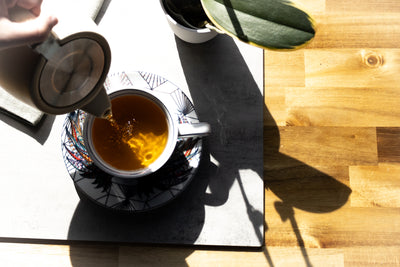White tea is a unique category of tea that has been around for a long time, similar to black tea. It originated in China's Fujian province and is known for being the least processed form of tea. White tea has gained attention for its purported health benefits.
Table of Contents
Types of White Tea
The highest-quality white teas, such as Silver Needle, are made from immature buds of the tea leaf. Visually, these buds still retain their white downy fuzz, which gives white tea its name. Other types, like Bai Mu Dan, consist of both buds and leaves. Different types of white tea have varying levels of whole versus broken leaves and bud-to-leaf ratios. Lower grades of white tea are often used in flavored blends.
Processing White Tea
White tea, sought after because of its minimal processing, still does undergo a few of the processing steps as other teas. The process of making white tea is simple. The tea leaves are picked, withered, lightly oxidized, and then dried.
What does White Tea taste like?
White tea is best described as delicate, with underlying flavors of hay, apples, cucumber, and melon often associated with it. Longer steeping times bring out more flavor. It may take some time for your taste buds to appreciate white tea if you are accustomed to strong coffee or soda, as it may initially seem mild. However, with time, you will come to appreciate the nuanced flavors of white tea.
Health Benefits of White Tea
White tea, like green tea, is rich in antioxidants. However, the levels of antioxidants can vary. Some white teas may have lower antioxidant content compared to certain green teas. The higher-end varieties of white tea generally contain more antioxidants. Some companies use white tea topically in creams, although the specific grade of white tea they use is unknown. Regardless, drinking white tea can provide many of the same benefits as green tea.
Caffeine and Antioxidant Content
The caffeine content in white tea can vary greatly, ranging from 6 to 75 mg. This variation is due to the type of leaf used. Higher-end white teas, such as Silver Needle, contain more caffeine than versions made with mature leaves. In fact, a silver needle white tea can contain more caffeine than a Chinese black tea. Trying white tea on your next long road trip can help you experience the difference in caffeine effects.
Fun fact: Caffeine is a natural pesticide, which is why the tips of tea leaves contain higher doses of caffeine.
Brewing White Tea
Brewing white tea is somewhat similar to brewing green tea, requiring cooler water temperatures compared to black tea. The steeping time can vary from 3 to 7 minutes. Higher-end white teas rarely become bitter. In fact, one method of brewing white tea involves putting some leaves in a cup and periodically replenishing the water until the flavor is fully extracted. Using a glass tea tumbler allows you to observe the brewing process.

